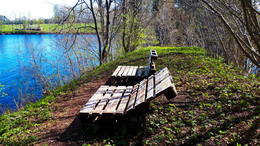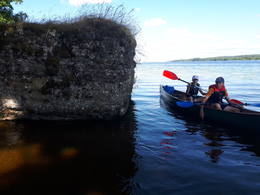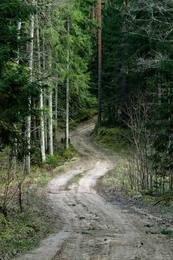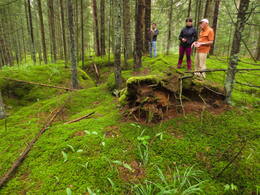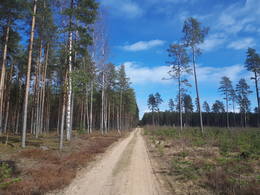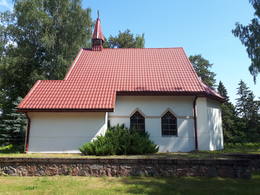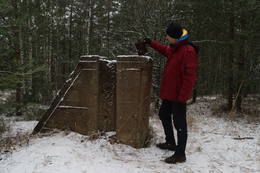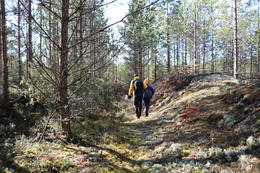Gyvenimas Kegumo pusėje Antrojo pasaulinio karo metu
Blykstelėjo prisiminimai apie dabar jau tolimus karališkuosius laikus. Vyresnei kartai tai primindavo jų pačių patirtį, o jaunesniajai kartai tai galėjo būti nuobodu.
Gyvenome labai gražioje vietoje kairiajame Dauguvos krante, maždaug už šešių kilometrų nuo Kegumo. Vietoje, kur 12 sodybų, bendrai vadinamų Priedesmuiža, iš vienos pusės apsuptos didelio miško, iš kitos – stataus Dauguvos kranto. Mūsų namus nuo kitų skyrė Ėgupytė, kurią vadinome ežeru, nes prie mūsų namų ji buvo platesnė, per ją ėjo dvi užtvankos. Vienos užtvankos vidurinę dalį vis dar jungia betoninis tiltas, kurį nuo sunaikinimo išgelbėjo vokiečių kareivis. Kitos užtvankos galai driekiasi į gelmes, ir joje nebėra buvusio aukšto medinio tilto. Kadaise jis tarnavo siaurajam geležinkeliui, kuriuo buvo gabenamas žvyras Kegumo elektrinės statybai. Po karo tiltas vis dar tarnavo, jo šonuose buvo vyraujanti simbolika – pjautuvai ir kūjai. Ėgupytė uodega driekiasi į visžalį mišką. Priedesmuižos viduryje yra vaikų rojus – dideli žvyro duobės su tvenkiniais ir laukiniais braškėmis. Miško pakraštyje yra du požeminiai šaltiniai su skaidriu vandeniu.
1941 m. birželis. Mama verkė sužinojusi, kad prasidėjo karas. Mano seseriai buvo dešimt metų, aš buvau jaunesnė. Turėjome nedidelį sodybą. Padėjo ir mano patėvis Juris Lazda, labai malonus ir romantiškas vyras. Nebegaliu pasakyti įvykių sekos, bet gerai prisimenu kai kuriuos epizodus.
Pabėgėlių vežimai ir kariai dieną naktį pravažiuoja pro mūsų namus. Žmonės miega vežimuose ir vagonuose. Gyvuliai pririšti prie vežimų galų.
Priedesmuiža pilna vokiečių. Naktį aukštai danguje tuščiaviduriai dūzgia bombonešiai. Prožektoriai bando juos pagauti spindulių sankirtose ir jie šaudo tarsi didžiuliai žaibai tamsiuose dangaus skliautuose. Čia ir ten jie numeta bombą.
Mūsų namas buvo maždaug už šimto metrų nuo tilto, tad mama, bijodama, kad namas gali būti apiplėštas, susikrovė savo daiktus į maišus ir nunešė juos į rūsį miško pakraštyje. Jai einant pasiimti kito krepšio, vyras jį pavogė ir nubėgo į mišką. Mudu su mama nuėjome į mišką ir ieškojome po tankiomis eglėmis, tikėdamiesi, kad vagis ten paslėpė krepšį, kad naktį jį vėl paimtų. Radome didelį stiklainį pomidorų tyrės, naują sluoksniuotos tešlos pyragą, šautuvą ir dar kai ką. Kas būtų pagalvojęs, kad po eglėmis auga visokie geri dalykai. Bet savo krepšio su daiktais neradome.
Bombos nepataikė nei į tiltą, nei į namą, bet šalia rūsio buvo išmušti du dideli krateriai.
Vokiečiai nedvejodami naikindavo po vieną kiaulę ar galviją ir įvedė savotišką draudimą ūkininkams naikinti savo gyvulius. Jie pavedė ūkininko sūnui Kārliui suskaičiuoti gyvulius. Taigi, tikriausiai prieš savo valią, jis apėjo visus namus. Jis atėjo ir į mūsų namus. Tuo metu mama buvo tvarte. Kārlis į tvartą neįėjo, bet paklausė, ar turime kiaulių. Mama atsakė, kad neturime. Tuo metu paršelis garsiai sucypė. Kārlis nusišypsojo ir pasakė: „Užsirašysiu, kad jų nėra.“ Po to patėvis miško tankmėje pastatė paršeliui trobelę ir aptvarą ir pats su juo nakvojo.
Vokiečiai į Negupytę mėtė granatas, susprogdindami žuvis. Didesnes pagavo, bet mažesnes, su į viršų išriestais pilvais, išplaudavo į krantus kaip baltas bangas ir skleidė nemalonų kvapą.
Kartą su mama ėjome plento pylimu, kai virš pylimo prasidėjo šaudymas, kulkos švilpė. Mama nubėgo nuo pylimo ir pašaukė mane sekti paskui ją. Tada ir atsiskleidė mano užsispyrusi prigimtis. Vėliau mama kaimynams pasakė: „...bet ta rupūžė neklauso, stovi ant pylimo ir tvirtina, kad nieko nebijo.“ Mes, vaikai, bėgiojome visur, iš tikrųjų nebuvo jokios baimės ir, stebuklingai, nė viena kulka mūsų nepataikė.
Kurį laiką gyventojams buvo įsakyta persikelti į Krūminių namų rūsius, tikriausiai savigynai. Po namu esantis rūsys buvo labai didelis ir storomis sienomis. Kiekviena šeima turėjo po vieną kiekvieno. Pasiėmėme būtiniausius smulkius daiktus. Visa kita liko likimo valiai namuose. Mama užkasė bulves sodo duobėje ir išlygino žemę. Tvarte po grindimis ji užkasė statinę sūdytos kiaulienos. Visur klajojo vištos, tarp jų ir mano turėta višta vardu Špicka. Taip pat turėjome didelę, storą, gražią katę vardu Janka. Kol gyvenome Krūminiuose, Janka, aplinkybių priverstas, virto miško broliu.
Vokiečiai mūsų tvarte įrengė arklides. O, kaip aš mylėjau tuos arklius! Jie juos maudė ten pat, Negupītėje.
Kadangi mano įtėvis jaunystėje buvo kolporteris, namuose turėjome daug gerų knygų. Vokiečiai knygas sumetė į vandenį, bet knygų lentyną radome miške su sudaužytu stiklu. Vokiečiai miške iškasė bunkerius ir į juos iš netoliese esančių namų nešė stalus, kėdes ir kitus baldus.
Vieną dieną mama atrado, kad vokiečiai iškasė mūsų bulves, jas verda ir vaišinasi. Tada ji nuėjo į arklidę gelbėti mūsų mėsos statinės. Ten stovėjo arklys. Mama liepė vokiečių arklininkui įkinkyti tą arklį ir nuvežti mėsos statinę į Krūminius. Vokietis neprieštaravo ir pakluso mamai.
Vokiečių kareiviai labiausiai mėgo šoninę ir kiaušinius. Jei išgirsdavome vištų kudakavimą, koks nors vokietis ar mes, vaikai, bėgdavome ieškoti kiaušinių. Kas pirmas juos rasdavo, tas ir gaudavo. Vokiečiai dažnai mus, vaikus, vaišindavo šokoladais. Jei koks nors vietinis gyventojas susirgdavo, eidavo pas vokiečių paramediką, kuris netgi duodavo jam vaistų.
Kartą mama išsiuntė mane į Lielvārdį nusipirkti maisto produktų. Turėjau nueiti apie tris kilometrus per mišką, tada keltu persikelti per Dauguvą. Grįždamas iškroviau krepšį pakelėje ir apsidairiau. Tada pamačiau vokiečius, ateinančius link manęs su vežimu, priekyje – du arkliai. Sumečiau viską į krepšį ir nuėjau jų link. Kai jie pasiekė vietą, kur sėdėjau, sustabdė arklius, ir vienas vokietis, kažką šaukdamas ir mojuodamas ranka, nubėgo paskui mane. Jei jie bėga paskui mane, tai aš turiu bėgti, ir bėgu taip greitai, kaip tik kojos neša. Atsigręžiau, jis vis dar bėgo ir bėgo. Aš taip pat. Nubėgau paskui vokietį, ir galiausiai jis sustojo. Namuose mama atrado, kad pamečiau piniginę su pinigais. Štai kodėl vokietis taip stengėsi mane pasivyti.
Šiek tiek užsidirbome rinkdami uogas ir grybus Lielvārdėje ir Kegume, už tai gaudavome vadinamuosius taškus. Pateikę taškus, galėjome nusipirkti produktų.
Kiekvieną dieną į Krūminių ūkį atvažiuodavo kaimiška virtuvė – nemažas puodas ant dviejų ratų. Tada kareiviai išsirikiavo su puodais. Pamaniau, kad ir aš galėčiau prisijungti prie tos eilės. Radau puodą ir atsistojau eilės gale. Kareiviai nusišypsojo. Atėjo mano eilė, ir malonus virėjas pripildė mano puodą.
Kartą įėjau į Krūminių virtuvę, kur vokiečiai valdė namus. Kareivis buvo aplipęs medumi iki alkūnių. Jis spaudė korius, ir medus tekėjo jo pirštais į dubenį. Šeimininkas tikriausiai buvo sukaupęs lipčių.
Vokiečiai dideliame rūsio koridoriuje turėjo telegrafą, kuriuo kareivis perduodavo užšifruotus pranešimus, bet mes, vaikai, stovėjome išsižioję. Mus domino viskas.
Vokiečiai Dauguvos krantuose įrengė žiūronus, o kai jų nebūdavo, vaikai išsirikiuodavo prie žiūronų, ir tada mes iš arti pamatėme Lielvārdį.
Kartais naktimis su mama išeidavome iš rūsio ir nuo kranto stebėdavome gaisrų atspindžius priešingame Dauguvos krante, kur dažnai degdavo namai. Juodo dangaus fone kilo kibirkštys ir dūmų stulpai.
Virš Kegumo elektrinės buvo pakelti didžiuliai balionai. Tačiau stoties užtvanka buvo subombarduota. Ten irgi kažkas degė, pats mačiau dūmų kamuolius. Vėliau virš sunaikintos atkarpos buvo pakabintas virtinis tiltas pėstiesiems, bet jis labai siūbavo.
Dauguvos vandenys tekėjo be kliūčių, todėl ji tapo daug siauresnė ir seklesnė. Ledo luitai gulėjo tiesiai ant vagos. Žegupytės viduryje atsivėrė seno malūno sienos su gilia duobe. Vokiečiai duobėje buvo įkasę dėžes su šoviniais. Kiekvienas galėjo pasiimti ką ir kiek norėjo. Dėžės buvo išlaužtos. Jose buvo įvairių dydžių blizgantys šoviniai su spalvingais ženklais. Kieme buvo paliktos vidutinio dydžio šuns dydžio padegamosios bombos. Kaimo gyventojai jas atsuko ir išpylė kuro. Tuščios bombos mums ilgai po karo tarnavo kaip tilto atrama. Taip pat buvo minų, panašių į pyragų dydį ir formą. Atvykę išminuotojai paklausė vaikų, kur yra minos, o mes jiems viską aprodėme ir todėl jautėmės svarbūs žmonės.
NRA. 2004-07-13. Kai vyko karas.
Susijusi laiko juosta
Susijusios temos
Susijusios vietos
Niega (Melderupė) ir apylinkės
Ėegos upė XX a. 5-ojo dešimtmečio žemėlapiuose vis dar vadinama Melderupi. Pastačius Kegumo HE, paskutiniai 2,6 km jos buvo užtvindyti, suformuojant daugiau nei 100 m pločio upės tęsinį. Siekiant aprūpinti Kegumo HE statybai reikalingu žvyru, rytiniame Ėegos krante buvo įrengtas karjeras, o per upę pastatytas geležinkelio tiltas. Žvyras į naują HE pastatą buvo gabenamas siauruoju geležinkeliu 6 km ilgio geležinkelio linija. Pirmieji du geležinkelio aikštelės kilometrai matomi tiek gamtoje, tiek LIDAR žemėlapiuose. Toliau geležinkelio aikštelė sutampa su šiuolaikiniu Jaunjelgavos – Kegumo keliu (P85). Vakariniame Ėegos krante, apie 0,2 km į šiaurę nuo Tiltininkų namo (savininkai prisimena Antrąjį pasaulinį karą ir su juo susijusius įvykius šioje vietoje), yra šaltinis – populiari vandens paėmimo vieta. XX a. abiejuose pasauliniuose karuose Ėegos apylinkėse vyko aktyvi karinė veikla. Pažvelgus į LIDAR žemėlapius ir gamtoje, į šiaurę nuo P85 kelio ir upės pakrantėse matomos apkasų pozicijos. Į pietus nuo P85 kelio iš pietvakarių prie užlietos Ėegos dalies ribojasi apie 0,8 km ilgio kopagūbris, kurio viršūnėje ir šlaituose iškastos apkasos. Mažo miško keliuko, jungiančio P85 kelią su Liepdegumių namais, pusėje yra atskira kopa, kurios šlaituose esančios stačiakampės duobės rodo, kad čia buvo pastatai ar sandėliai. Minėtą kopą iš šiaurės ir vakarų supa maždaug kilometro ilgio apkasų juosta. Į pietus nuo P85 kelio taip pat matomos žmogaus sukurtos neigiamos reljefo formos. Gamtoje yra tankus apkasų ir pastatų arba/ir sandėlių tinklas (įvairaus dydžio duobių tinklas), kuris taip pat matomas LIDAR žemėlapiuose rytiniame Žegos krante tarp P85 kelio ir Širmeliupytės. 1,8 km į rytus nuo Žegos yra Lezmanių brolių kapinės. Jas galima pasiekti nedideliu miško keliuku, vingiuojančiu aplink Žegą ir Širmelupytę. Trečioji (toliausiai į pietus) apkasų linija, pažymėta Latvijos nacionalinės bibliotekos žemėlapyje „Zusammendruck Riga, Gezeichet u.gedruckt vd Vermessungs“, LIDAR žemėlapiuose ir gamtoje aiškiai matoma ir šiandien – po šimtmečio.
Vokiečių armijos betoninis ugnies punktas prie Kegumo HE rezervuaro Žegos upės žiotyse
Įsikūręs Kegumo HE rezervuare prie Žegumo upės žiočių (priešais Žegumo namus), kairiajame jos krante. Vienas vizualiai ir vaizdingai įspūdingiausių bei geriausiai išsilaikiusių betoninių gaisrinių, skalaujamų Dauguvos bangų. Jį galima pamatyti iš didesnio atstumo. Nuo kranto iki gaisrinės viršūnės (apaugusios žole) pastatytas pėsčiųjų tiltas. Į gaisrinės betonines sienas įmūryti siaurojo geležinkelio (?) bėgiai. Į jį galima patekti nuo pėsčiųjų tilto. Tai vienas iš Vokietijos armijos Pirmojo pasaulinio karo gynybos linijos ugnies taškų kairiajame Dauguvos krante, kurį galima daugiau ar mažiau atsekti per visą Dauguvos kairįjį krantą. Minėta gynybos linija yra didelio masto karinė sistema, kuri dar nėra iki galo įvertinta kaip vientisas darinys. Gaisrinės liekanas galima apžiūrėti plaukiant valtimi Kegumo HE.
Princo Leopoldo kelias (Prinz – Leopold Straße)
Pirmojo pasaulinio karo vietos (kelio) pavadinimas yra „Prinz – Leopold Straße“ – Kunigaikščio Leopoldo kelias. Istorinis miško kelias arba jo vieta, apie 7 km ilgio, prasidėjo Didžiojo Kurfürsten Damm ir Kaiser Damm sankryžoje prie vadinamojo Kurlando paminklo (Kurland Denkmal) ir vingiuoja per mišką Birzgalės link, susijungdamas su Pirmojo pasaulinio karo siaurojo geležinkelio linija: Lāčplēsis – Latgale. Į vakarus nuo kelio ir apie 2 km į pietus nuo Kurlando paminklo (Kurland Denkmal) yra Pirmojo pasaulinio karo šaudykla. Šiandien Kunigaikščio Leopoldo keliu galima vaikščioti pėsčiomis, važiuoti dviračiu ir automobiliu (tinkamomis sąlygomis). Kelias kerta Konupītę ir Žegos intaką.
Manoma, kad vokiečių armijos kareiviai, ilgą laiką praleidę kairiajame Dauguvos upės krante, šį kelią pavadino Bavarijos princo Leopoldo (1846–1930), kuris Pirmojo pasaulinio karo metu vadovavo Vokietijos ir Austrijos-Vengrijos pajėgoms Rytų fronte, vardu.
Galima Otomaro Oškalno bunkerio vieta
Atoki ir sunkiai prieinama vieta yra didelis miškų masyvas, esantis apie 200 m į vakarus nuo Žegos upės ir apie 0,5 km į pietvakarius nuo Žegos užliejamos lygumos. Į minėtą vietą rekomenduojama nuvykti pėsčiomis arba dviračiu, naudojantis LIDAR žemėlapiais ir geografinėmis koordinatėmis. Minėtoje vietoje yra maždaug kilometro ilgio (V – R kryptimi) ir pusės kilometro pločio (Š – P kryptimi) natūralus kopų kalnagūbris, apaugęs spygliuočių mišku. Kopų masyvo šiaurinio ir rytinio šlaitų viršutinėse dalyse yra gerai išsilaikę apkasai, spėjama, iš Antrojo pasaulinio karo laikų. Harijs Jaunzems (buvęs Kegumo HE inžinierius) mano, kad šioje vietovėje (konkreti vieta nežinoma) buvo Otomāro Oškalnso suformuoto Raudonosios armijos partizanų būrio bunkeris.
Didžioji rinkimų krantinė (Große Kurfürsten Damm)
Maždaug 4 km ilgio, vakarų-rytų kryptimi driekiantis miško kelias tokiu pavadinimu, pažymėtas Pirmojo pasaulinio karo žemėlapiuose, prasidėjo prie buvusio Kurlando paminklo (Kurland Denkmal) arba vėliau populiariai vadinto Mātīte paminklu ir baigėsi dviejų kelių (prieinamų gamtoje) Hütten Straße ir Morgen Straße sankryžoje. Maždaug 2 km jis driekiasi kaip tiesus miško-žvyro kelias, 0,8 km – kaip žvyrkelis (sutampantis su Latvijos valstybinių miškų nutiestu Egles-Kaulupe keliu), o likusi dalis – kaip takas – nepravažiuojamas automobiliu, bet pravažiuojamas gamtoje arba dviračiu. Sprendžiant iš kito žemėlapio (Zusammendruck Riga, 1: 100 000) ir LIDAR žemėlapių, Pirmojo pasaulinio karo metu Didžiosios Kurfirst užtvankos ir Morgen Straße sankryžoje buvo vokiečių armijos stovykla arba sandėliai (Lager).
Manoma, kad pavadinimas, kilęs iš Kurfürstendamm gatvės, vienos iš centrinių Berlyno gatvių (pavadintos Brandenburgo rinkėjų vardais), kuri šiandien yra populiari turistų ir apsipirkimo vieta. Gatvės pavadinimas pirmą kartą paminėtas 1767–1787 m.
Tomo evangelikų liuteronų bažnyčia
Pirmoji žinoma bažnyčia Tomėje pastatyta 1644 m. 1907–1908 m. vietoj medinio pastato barono Šilingo lėšomis buvo pastatyta mūrinė bažnyčia. 1956 m. bažnyčia buvo nugriauta, o iš jos akmenų pastatytas kolūkio vištidinis ūkis. Šiandien matoma bažnyčia, esanti tarp buvusios Tomės pradinės mokyklos (mokykla buvo uždaryta po mokyklų reformos, ten buvo įkurtas Kegumo regioninis muziejus) ir Tomės kapinių, buvo pastatyta 1999–2003 m. Briežių šeimos (JAV) iniciatyva. Dabartinį altorių nutapė Sandijs Greiškāns iš Kegumo, remdamasis Atos Grundės 1932 m. daryta altoriaus nuotrauka. Vargonus bažnyčiai padovanojo liuteronų parapija iš Švedijos.
Latvijos nacionalinės bibliotekos (LNB) kolekcijoje „Dingusi Latvija“ yra Tomės bažnyčios nuotrauka, kurioje matyti jos sunaikinimas 1916 m. Pirmojo pasaulinio karo metais. Tų pačių metų mūšiuose nukentėjo ir šalia bažnyčios esanti Tomės pradinė mokykla.
1938 m. „Latvijas Kareivī“ numeryje yra straipsnis „Pa ddimtās zemes istēlstam un ciemiem“, kuriame minima Tomės bažnyčia: … „Be to, kelias veda pro Tomės bažnyčią, kurią 1916 m. sugriovė rusai, manydami, kad tai vokiečių stebėjimo postas. Maža parapijiečių bendruomenė – apie 250 narių – 1922 m. su didele energija ėmėsi bažnyčios renovacijos ir per 10 metų pastatė naują bokštą ir altorių su menininko Grunde altoriumi. Dabar bažnyčia su baltomis sienomis, rudais langų ir durų rėmais bei tvarkingu interjeru palieka malonų įspūdį“.
Buvusi Tomo pradinė mokykla
Buvusi Tomės pradinė mokykla yra tarp Baldonės-Tomės kelio (V4, Pirmojo pasaulinio karo žemėlapyje vadinamas „Düna Straße“), Tomės evangelikų liuteronų bažnyčios ir Tomės kapinių. Mokykla, kaip ir greta esanti bažnyčia, nukentėjo Pirmojo pasaulinio karo mūšiuose (1916 m.). Latvijos nacionalinėje bibliotekoje (LNB) „Dingusi Latvija“ eksponuojama pirmosios Tomės mokyklos Silinių name nuotrauka (1925 m.). Dabartinis mokyklos pastatas pastatytas 1926 m. Po mokyklų reformos mokykla buvo uždaryta. Šiandien jame įsikūręs Kegumo krašto muziejus ir biblioteka. 2017 m. gruodžio 13 d. muziejaus kiemelyje atidengta Aigaro Zemītio skulptūra „Žmogui reikia šuns“, skirta Reginai Ezerai. Ant pastato sienos įrengta atminimo lenta į Sibirą ištremtiems Tomės gyventojams.
Ratos kalva
Aukščiausias sausumos kopų masyvo taškas, esantis į vakarus nuo Tomeso kaimo, yra Ratos kalnas (67,8 m virš jūros lygio). Jo apylinkėse stūkso šviesūs pušynai, nuo kurių atsiveria geras vaizdas į įspūdingų kopų ataugas ir šlaitus. Ratos kalną lengva pasiekti pėsčiomis (0,6 km) iš Latvijos valstybinių miškų (LVM) poilsio zonos „Sēņotāju māja“. Abiejose nedidelio miško keliuko, kuriuo einame kalno link, pusėse gamtoje (ir LIDAR žemėlapiuose) matomos daugiau nei 40 panašaus dydžio stačiakampių duobių ir trys apie 50 m ilgio tranšėjos. Gali būti, kad Pirmojo pasaulinio karo metu čia buvo vokiečių armijos sandėlis, iš trijų pusių apsuptas netoliese esančių kopų. Manoma, kad betoninės konstrukcijos aukščiausiame Ratos kalno taške yra buvusio gaisrų stebėjimo (ar trianguliacijos?) bokšto liekanos, kurio medinės dalys buvo pritvirtintos prie betoninių stulpų. Straipsnį apie slidinėjimo kelionę į Ratos kalnus galima rasti sovietmečio periodiniame leidinyje. Kasmet Rata kalvų apylinkėse rengiamas grybų rinkimo čempionatas.
Šaudykla (Schießstand)
Jis yra didesniame miškų masyve tarp Žegos, buvusio Kurlando paminklo (Kurland Denkmal), netoli vadinamosios Princo Leopoldo gatvės (Prinz – Leopold Straße). Nežinantiems objektą gali būti sunku rasti, todėl paieškai rekomenduojama naudoti geografines koordinates.
Manoma, kad tai buvo po atviru dangumi įrengta šaudykla, kurią Pirmojo pasaulinio karo metu pastatė vokiečių armija šaudymo pratyboms. Pirmojo pasaulinio karo laikų žemėlapyje ši vieta pažymėta „Schießst“. Manoma, kad ji tarnavo kaip šaudymo pratybų aikštelė („Schießstand“ vokiškai – šaudykla). Tomi kryptimi (į Tomi) minėtame žemėlapyje pažymėtos dar dvi šaudyklos. Arčiausiai Tomi esančią galima rasti ir pamatyti gamtoje.
Teritorija aplink šaudyklą apaugusi jaunomis pušynėmis, vietovėje gyvena vilkai (galima rasti jų išmatų). LIDAR žemėlapiuose ir gamtoje į pietryčius nuo šaudyklos matoma ištisinė 1,5 km ilgio apkasų linija, tačiau šiaurės vakaruose trumpų (apie 50 m ilgio) ir nutrūkstamų apkasų linija tęsiasi iki pat Kegumo HE. Gamtoje objektas atrodo kaip maždaug 300 m ilgio, tiesus, šiaurės rytų-pietvakarių kryptimi orientuotas „praėjimas“, kurį iš abiejų pusių supa iki 2 m aukščio kerpėmis ir samanomis apaugę pylimai. Aukščiausias pylimas yra šaudyklos gale (3–4 m). Šaudyklą supa tokio pat dydžio stačiakampės duobės.





